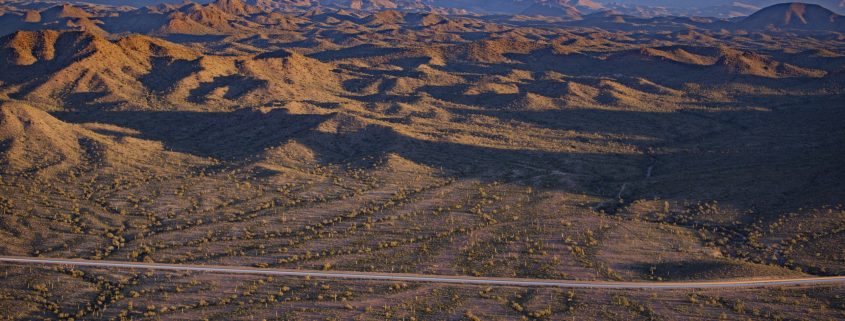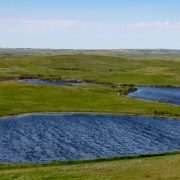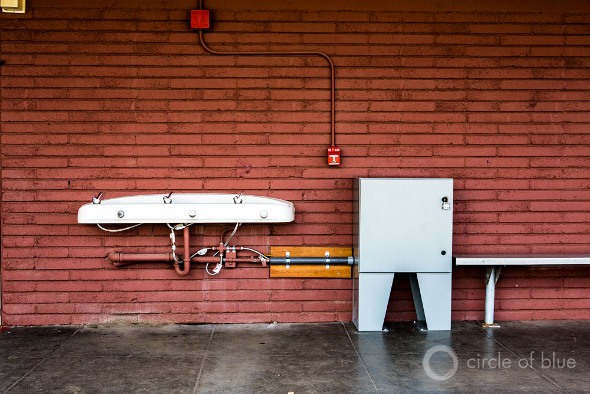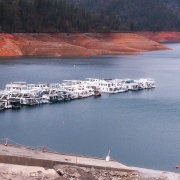Marriage Of Coal And Water In Arizona Renews Vows
U.S. government moves to extend lease for coal plant that pushes the Colorado River uphill.
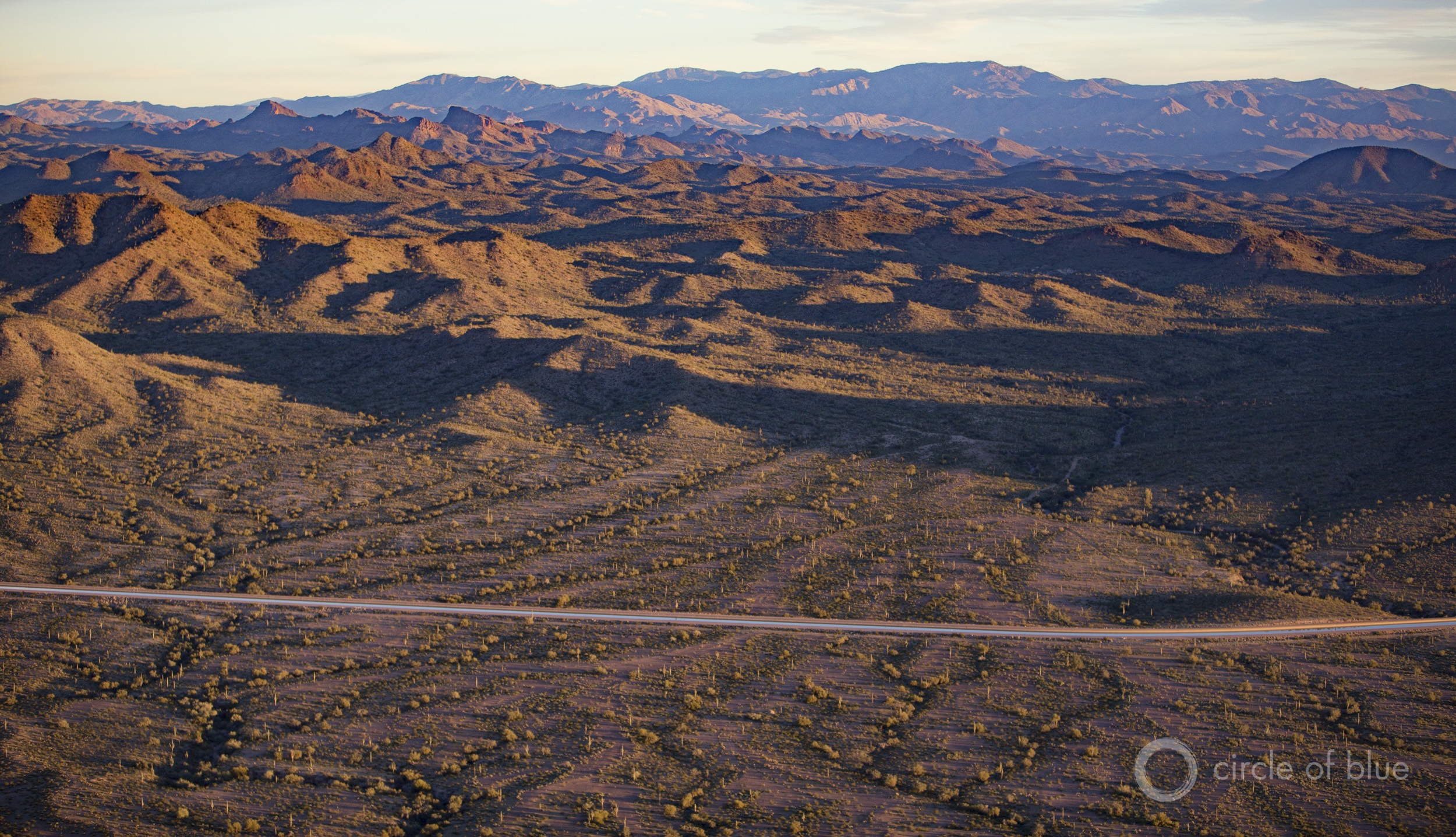
Navajo Generating Station, a coal plant in northeast Arizona, provides the power for the Central Arizona Project canal, the thin thread in the foreground. Photo © J. Carl Ganter / Circle of Blue
By Brett Walton, Circle of Blue
A five-decade-old bond in Arizona between coal power and the delivery of Colorado River water to cities, tribes, and farms may last another quarter-century.
The Obama administration proposes to extend through 2044 the lease agreements for Navajo Generating Station, a 2,250-megawatt coal-fired power plant on Navajo land in northeastern Arizona, and Kayenta mine, the plant’s coal source. Together, the facilities made Arizona the state it is today.
The union of coal and water is a foundation of Arizona’s economic and political rise in the latter half of the 20th century, and a monument to a bygone era of colossal engineering projects. Navajo Generating Station provides nearly all the electricity to push the Colorado River uphill to Tucson. Like a river in reverse, the water moves through the 336-mile Central Arizona Project canal, which supplies close to one-third of municipal water in the state. The canal, by some accounts, is Arizona’s most important economic asset, aiding the population boom in the Phoenix-Tucson corridor and providing an alternative to limited groundwater reserves that acted as a natural constraint on growth.
The Obama administration’s decision, laid out in a draft environmental review that was published on September 30, runs counter to energy trends. The coal industry is cratering in the United States, with coal rapidly losing market share to cheaper natural gas, wind, and solar power. Coal is also a dirty energy source, adding heat-trapping carbon to the atmosphere, a form of pollution that President Obama pledged to limit last month when he signed the Paris Agreement, an international climate pact. Among U.S. power plants, Navajo Generating Station is the seventh largest source of carbon dioxide, releasing 15.4 million tons of the gas in 2015. Continuing to increase the amount of carbon in the atmosphere almost guarantees a drier, hotter Colorado River Basin. The Navajo facility is a drop in the bucket compared to total global carbon emissions, but it is a symbolic drop in a region where water supplies will be severely diminished as the planet warms.
In this case, however, none of that matters. Climate considerations regarding Navajo Generating Station are of secondary importance to the federal government. Its overriding interest in the power plant, according to the Bureau of Reclamation’s Sandra Eto, is twofold: keeping water relatively cheap by providing reliable power for the Central Arizona Project, and helping Arizona pay off its lifeline canal by selling surplus electricity produced at Navajo.
The bureau was urged to consider replacing the coal-fired plant with renewable or lower-carbon power — a majority of public comments made that recommendation — but in its analysis the bureau determined that doing so would be incompatible with its two goals. Building a new solar array or a natural gas plant to fully replace the Navajo facility, or even buying power to replace just the federal government’s ownership stake, which is one-quarter of the plant’s capacity, was too costly, the bureau said. The future price of natural gas was too uncertain, and no extra power would be generated to help pay down the roughly $US 1.2 billion that remains on the canal’s repayment bill.
“We came to the conclusion that there is very likely no full replacement alternative that would allow for surplus energy,” Sandra Eto, Navajo Generating Station project manager, told Circle of Blue.
Instead, the bureau considered several partial replacement scenarios: swapping either 100 megawatts or 250 megawatts of the government’s 547-megawatt share for natural gas or renewable power contracts. It also considered decommissioning Navajo once the original lease expires in 2019.
In the end, federal officials — just as Navajo officials did in 2013 when they agreed to the lease extension — decided that maintaining the status quo at the Navajo station is the preferred course of action. Coal for the plant would continue to be sourced from Kayenta, a mine located on Navajo and Hopi lands and owned by Peabody Energy, a coal company that filed for bankruptcy protection in April.
Water-Energy Links
The supply chain for Arizona’s big water-coal connection is relatively straightforward. Kayenta mine is the sole provider of coal for Navajo Generating Station. The power plant is cooled by water drawn from Lake Powell, between 26,000 and 29,000 acre-feet of water per year. The water is not returned to the Colorado River system. On the energy side, Navajo Generating Station is essentially the sole power source for the Central Arizona Project pumps, accounting for more than 90 percent of its electricity.
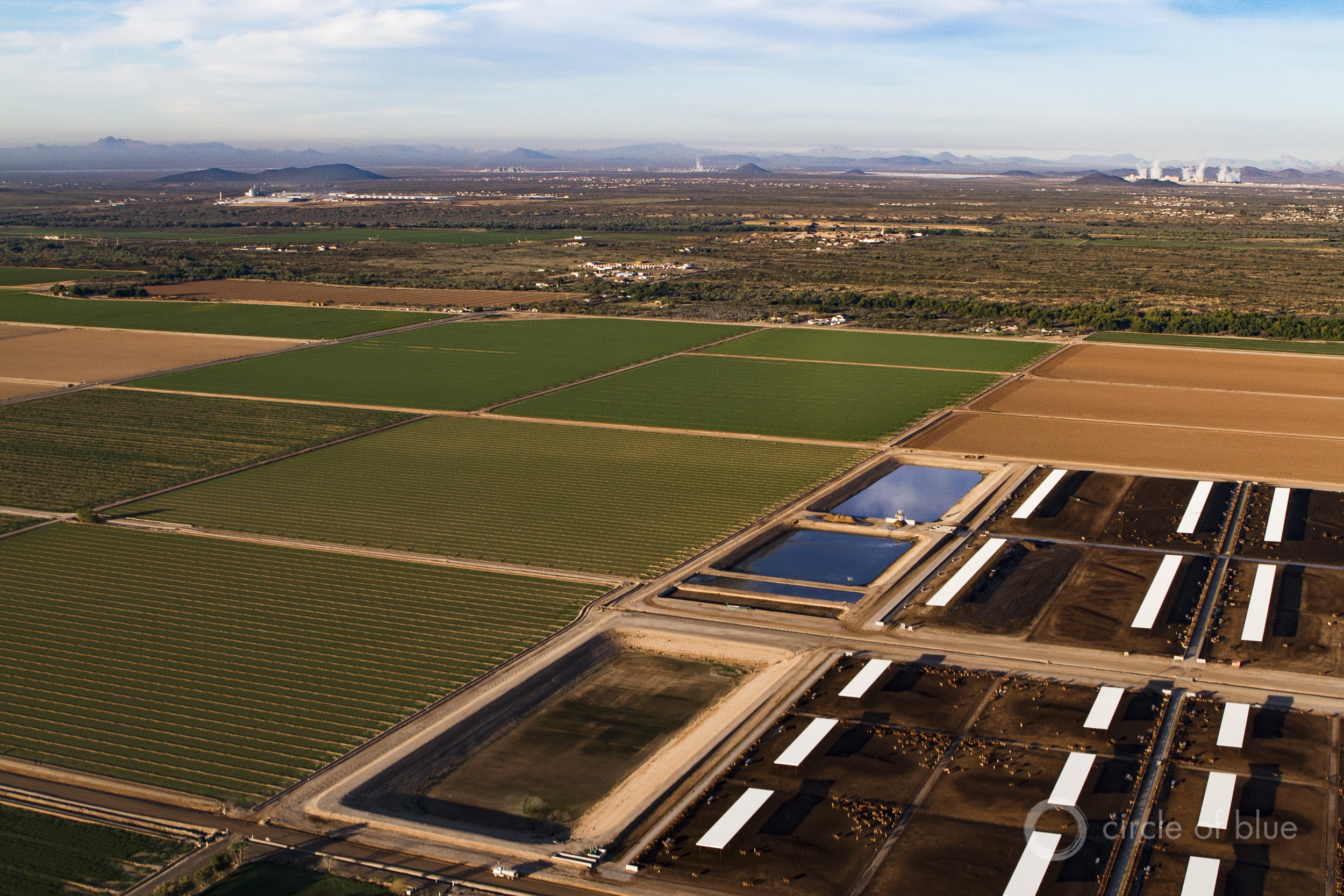
The Central Arizona Project canal is one of the state’s most important assets, serving a region where four out of five Arizonans live and providing irrigation water for cities, farms, and tribes. Photo © J. Carl Ganter / Circle of Blue
The ownership of these assets, however, is more tangled. The federal government owns a quarter of the generating capacity at the Navajo facility. The rest is split between Arizona Public Service, Salt River Project, NV Energy, and Tucson Electric Power. Two-thirds of the government’s share is used to run the canal pumps that lift the Colorado River nearly 3,000 feet in elevation. Revenue from the other third, sold on the open market, is deposited into the Lower Colorado River Development Fund, which pays off the construction cost of the canal. The most valuable portion — power at midday during summer — is sold to Salt River Project on a long-term contract. The rest is marketed by the Western Area Power Administration (WAPA). While WAPA sales generate revenue, they have not been profitable recently because natural gas is so cheap. The surplus power sales are still a net gain because of the Salt River contract, but the overall earnings have declined. That means an increase in water rates. For certain customers, CAP water charges will climb 8 percent over the next two years in order to make up for less revenue from surplus power.
Even as the federal government moves ahead with a lease extension, key partners are devising an exit strategy in case alternatives become more economical. The board of the Central Arizona Water Conservation District, which operates the Central Arizona Project, approved a plan in October 2015 for replacing Navajo Generating Station power.
The strategy relies on swapping Navajo’s coal power with natural gas from a “portfolio” of contracts and purchase agreements. Under this strategy, which depends on the future price of gas, no single facility would provide more than 15 to 20 percent of the canal’s power. Such a move depends on the price of gas. Under scenarios modeled by the National Renewable Energy Laboratory, pumping costs using existing natural gas power could be 23 percent cheaper or 21 percent more expensive than keeping Navajo Generating Station open, depending on fluctuations in gas prices.
“If we acquired additional power resources now that would only increase the NGS [Navajo Generating Station] surplus that is left for WAPA to sell, and those sales are losing money,” Tom McCann, deputy general manager of the Central Arizona Project, told Circle of Blue in an email. “Therefore, it is not economic for CAP to acquire additional resources while we still have NGS.”
Uncertainty Ahead
A number of other unresolved questions hang over Navajo Generating Station. One is ownership. NV Energy has indicated that it will sell its stake in the facility. If no buyer is found one of the power plant’s generating units could be shut down.
A second question is the endorsement of the Navajo Nation. The tribal council approved the lease extension in 2013, and negotiated $US 43 million per year in royalty payments. However, if ownership stakes were to change such that a new lease amendment had to be negotiated, then that could reopen the agreement, Eto said. Navajo leaders and the federal government are keen to promote the economic and employment benefits of the coal mine and power plant, but community activists worry about health and environmental problems from bad air. Nitrogen oxides from the plant contribute to the haze that veils a region renowned for its desert scenery.
A third question relates to water. Colorado River water was delivered to central Arizona starting in the 1980s in order to reduce the demand for groundwater, which was causing aquifers to decline and the land to sink. The Bureau of Reclamation says that it wants to keep water cheap enough that users are not tempted back to groundwater.
“In order to keep CAP water as a reasonable replacement for pumping groundwater, it has to be competitively priced,” Eto told Circle of Blue.
Others are skeptical of that justification. Martin Pasqualetti, an Arizona State University professor and co-director of the Energy Policy Information Council, argues that a higher price for water is an incentive to reduce waste. Arizona is not getting any more water, and may soon get less, if the lower Colorado River Basin tips into a mandatory shortage.
There is still time for debate. The Bureau of Reclamation will hold 11 public meetings in Arizona in October and November. A final environmental review is expected by the fall of 2017, Eto said.
Brett writes about agriculture, energy, infrastructure, and the politics and economics of water in the United States. He also writes the Federal Water Tap, Circle of Blue’s weekly digest of U.S. government water news. He is the winner of two Society of Environmental Journalists reporting awards, one of the top honors in American environmental journalism: first place for explanatory reporting for a series on septic system pollution in the United States(2016) and third place for beat reporting in a small market (2014). He received the Sierra Club’s Distinguished Service Award in 2018. Brett lives in Seattle, where he hikes the mountains and bakes pies. Contact Brett Walton

